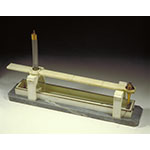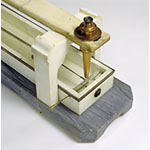The gray marble rectangular base rests directly on the ground. The base carries a smaller rectangular trough of white marble for the long asymmetric magnetic needle. The trough is surmounted by two profiled marble arches connected at the top by a marble strip, with two openings. Through one of the openings passes a glass tube terminating in a brass cap. The other opening accommodates a microscope used for accurately determining the needle's movement (the microscope also fits in the opening of item inv. 918). This type of inclinometer is fairly similar to those described by Charles-Augustin Coulomb in 1785. The wire suspension made the instrument highly sensitive, while its massive structure made it extremely stable. In the instruments he designed, Coulomb exploited the results of his detailed research on wire torsion and magnetization. This specimen was made by the Museo di Fisica e Storia Naturale of Florence, and was thus formerly in the Lorraine collections.











